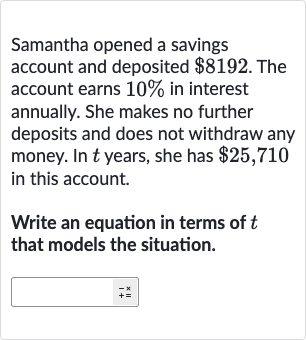AI tutor
Full solution
Q. Samantha opened a savings account and deposited . The account earns in interest annually. She makes no further deposits and does not withdraw any money. In years, she has in this account.Write an equation in terms of that models the situation.
- Convert to Decimal: Write as a decimal.$r = \(10\)\%\(\newline\)= \frac{\(10\)}{\(100\)}\(\newline\)= \(0\).\(10\)
- Calculate Growth Factor: Determine the growth factor \(b\) for the account balance. For exponential growth, \(b > 1\). Growth factor: \(b = 1 + r\)
- Calculate b Value: Calculate the value of the growth factor \(b\). Substitute \(r = 0.10\) into \(b = 1 + r\). \(b = 1 + 0.10\) \(b = 1.10\)
- Identify Initial Amount: Identify the initial amount \(a\) deposited into the savings account.\(\newline\)Initial amount \(a\): \(\$8192\)
- Write Exponential Equation: Write the exponential equation in the form \(y = a(b)^t\) that models the account balance, \(y\), \(t\) years after the initial deposit.\(\newline\)Substitute \(\$8192\) for \(a\) and \(1.10\) for \(b\) into \(y = a(b)^t\).\(\newline\)\(y = 8192(1.10)^t\)
More problems from Write exponential functions: word problems
QuestionGet tutor help
QuestionGet tutor help
QuestionGet tutor help
QuestionGet tutor help
QuestionGet tutor help
QuestionGet tutor help
QuestionGet tutor help
QuestionGet tutor help
QuestionGet tutor help

